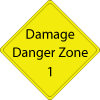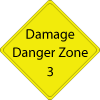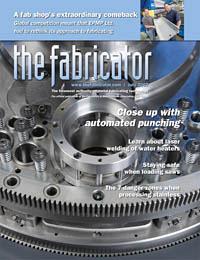Contributing Writer
- FMA
- The Fabricator
- FABTECH
- Canadian Metalworking
Categories
- Additive Manufacturing
- Aluminum Welding
- Arc Welding
- Assembly and Joining
- Automation and Robotics
- Bending and Forming
- Consumables
- Cutting and Weld Prep
- Electric Vehicles
- En Español
- Finishing
- Hydroforming
- Laser Cutting
- Laser Welding
- Machining
- Manufacturing Software
- Materials Handling
- Metals/Materials
- Oxyfuel Cutting
- Plasma Cutting
- Power Tools
- Punching and Other Holemaking
- Roll Forming
- Safety
- Sawing
- Shearing
- Shop Management
- Testing and Measuring
- Tube and Pipe Fabrication
- Tube and Pipe Production
- Waterjet Cutting
Industry Directory
Webcasts
Podcasts
FAB 40
Advertise
Subscribe
Account Login
Search
Keeping stainless flawless for appliance stamping, fabrication
Processing stainless safely through 7 damage-danger zones
- By Jim Russell
- July 10, 2007
- Article
- Bending and Forming
Appliances are increasingly being made of stainless steel to satisfy consumers' growing demands for these high-end products. According to the Association of Home Appliance Manufacturers (AHAM), the use of stainless steel in home appliances has increased in the last five years and is expected to continue to grow. Nearly 20 percent of all ranges, dishwashers, and refrigerators sold have a stainless steel finish. Additionally, microwaves, outdoor grills, and even washers, dryers, toasters, and coffeemakers are being constructed with stainless steel and highly polished stainless steel surfaces.
Stainless steel series 301 and 304 are the most widely used grades for appliance manufacturing, but others, such as 200- and 400-series, also are being used. In some cases, a film is applied to the steel surface to make it look like stainless steel.
Stainless steel's polished finish and high strength make it more difficult than carbon steel to process—cut-to-length and slit—before it is stamped, bent or folded, and fabricated into an appliance. Because it's easy to scratch or damage the surface of stainless steel, you must pay extra attention to your coil processing equipment and handle this material with great care.
The rewards can be great, however, because typically you can command higher prices—and therefore greater profit—for stainless steel appliance processing and fabrication.
Safely Navigating Seven Damage-Danger Zones
Every point in a coil processing line where the stainless steel touches another surface is an opportunity for damage—a virtual damage-danger zone.
By understanding the potential for damage, and assessing risk in key areas, you can ensure each component in the processing line is designed and equipped properly to protect the coil's surface and to process it effectively and efficiently To reduce the risk of scratching the surface during processing, pay particular attention to these areas:
- Uncoiler (slitting, cut-to-length, stamping)
- Leveler (slitting, cut-to-length, stamping)
- Slitter (slitting)
- Roll feed and shear (cut-to-length, stamping)
- Stacking system (cut-to-length, stamping)
- Tension stand and recoiler (slitting)
- Coil handling (slitting, cut-to-length, stamping)
Uncoiler
To prevent tension scratching at the unwind stand, or uncoiler, you must unwind with approximately the same amount of tension that was used to wind the coil originally. Loosely wound coils are difficult to process because it is easy to pull one wrap over another.
Mark a straight line on the side wall of a coil before you process it to help identify the correct payoff tension. Any movement of the side wall straight line during processing indicates improper brake settings.
Uncoilers have an adjustable brake to ensure proper tension. Insufficient or excessive braking can cause movement in the coil and subsequent scratching. To avoid excessive braking and the movement that results from a coil that is too loose, keep the tension constant as you process the coil. This requires reducing the braking force as the coil unwinds.
Bright-finished and polished stainless typically is supplied from the mill with paper interleaved between each wrap. As the coil unwinds and the interleaved paper unravels, the paper must be rewound on a driven mandrel.

Seven processing line zones present opportunities to damage stainless steel before it gets to the press, press brake, folder, or punching machine to be fabricated into an appliance.
Leveler
If the stainless requires leveling, be sure to choose the correct roll configuration for the leveler. This will reduce or eliminate surface damage. In surface-sensitive metal coil processing, a five- or six-high leveler is appropriate. Typically, stainless steel requires a six-high configuration. The key is the extra set of intermediate rolls between the work rolls and backup rolls. This distributes the force on them, reduces wear on the work rolls, and decreases the chance for surface markings.
If no loop is present between the leveler and roll feed, constant speed matching from the leveler to the press feed is necessary to reduce scratching.
If you must stop the line to change or index pallet stacks, a creep mode can be used. Creep mode accumulates material from the unwind stand and leveler into a pit at a low speed. This prevents the leveler rolls from introducing coil set or creating roll marks.
In any case, be sure to clean the leveler rolls frequently to prevent contaminants from damaging the material.
Slitter
When it is operating properly, the slitter head is one of the least likely components to scratch or damage the finished surface of a coil. When marking does occur at the slitter head, it usually appears as knife marks.
To avoid knife marks and coil damage at the slitter head, check the knife stripper ring diameters for proper sizes. If the relationship of the rings relative to the gauge and hardness of the strip is not proper, the knife edge is likely to mark the material.
Also, because of stainless steel's high tensile strength (100,000 pounds per square inch) compared to carbon steel's strength (65,000 PSI), the knife penetration and side clearance must be properly set to obtain the correct shear angle and cut quality. Only 5 percent knife penetration is required to complete the shear angle on stainless, much less than the 25 percent to 30 percent knife penetration for mild steel. Excessive penetration can overload the slitter arbors, causing deflection and poor-quality cuts.
Roll Feed
You can prevent surface damage by maintaining proper friction between the roll feed and the material. Because the feed roll pulls material out of a shallow loop, select the roll preparation, such as a fine-grit finish, polyurethane, or felt-covered roll, so that it does not mark the stainless. Roll location and diameters also become critical with surface-sensitive stainless.
Rolls should be free-spinning to allow easy movement and constant material speed. You can add nonmarking backup rolls to support the feed rolls and help prevent surface damage.
At the shear, it is critical to ensure that the stainless strip feeds over the bottom knife without touching it. You can keep the strip from touching the knife by using a properly designed feed table.
As with the slitter, you must have proper knife clearance to achieve a good-quality cut; use a shear that allows you to adjust knife clearances.
Stacking System
Pay particular attention to the stacking system's machine design, material support, and cushioning. Stackers should be designed to eliminate marking or denting the stainless.
Just about all stainless steel grades are nonmagnetic, so you need to use flipper and drop stackers to stack the material. Flipper stackers drop material from overhead by rotating L-shaped supports, similar to a horizontal door. The supports should be designed with driven rolls or constructed of material that won't mark the material. Driven rolls should be tightly controlled between the feed rolls to eliminate a speed differential.
Drop stackers feed the material out and drop it when the shear cuts the sheet. Make sure to support long blanks, so the newly cut piece does not scratch the material already in the stack when it is pushed forward. One technique you can use is an air current to "float" the sheet to rest.
Tension Stand and Recoiler
Tension stands keep coils tight, and must be used in slitting lines, but they also represent one of the greatest potential for damage to the stainless steel's sensitive surface.
The three types of tension stand designs are pad, roll/pad combination, and roll-only. Pad-type tension units pull material through; as the material is pulled, pads catch debris that becomes embedded and can cause ongoing damage to material. The roll-only tension stand, which uses two rolls moving in synchronization with the material, is the only configuration designed specifically to prevent damage to the stainless steel's surface.
With a roll-style tension stand, you must consider the material from which the tension rolls are made. In most applications, polyurethane rolls are best-suited for running clean and dry stainless steel.
Movement between adjacent laps of a coil, similar to the tightening or release of a clock spring, causes tension scratches, also called pull marks. Also, improper tension can cause loose coils or "V-checking" (indentation at the drum's gripper bar caused by excessive tension) at the recoiler drum and can cause damage to a stainless steel coil. Therefore, set tension values that are gauge-dependent properly and adjust them correctly for surface-sensitive stainless.
Large openings in recoilers can create reel marks, which are heard as "thumps" as the coil is being wound. You can use precision-ground drums that provide an almost seamless surface to decrease the potential for damage.
Coil Handling
If you handle the coil throughout the processing operation carefully, you'll realize a measurable payback. Damage such as a dent or gouge to the first wrap of the coil can cause damage to the inner wraps, creating scrap from a large section of expensive material.
Because stainless steel is such a high-priced metal, proper protection of the coil's surface is especially important. You should wrap the stainless steel with paper to protect the finished surface. You can also apply a protective film, such as vinyl, during processing, to protect the material's surface during the next processing step or while it is stored or shipped.
The cleanness of the equipment is very important; any surface that touches the stainless steel must be free of oil or grease. On a bright-annealed or polished stainless, oil or dirt is easily identified and subject to rejection.
Low-friction transfer table technology, which initially was developed to handle lightweight products in the paper industry, can reduce scratching in coil processing lines.
Rolls and the supports between them can potentially contact the stainless as it passes across transfer tables. Most scratches occur when roll speeds differ from the coil speed, or when the metal touches a support surface that is not appropriate for stainless steel.
A polyurethane coating or thick felt is recommended for C-hooks. The cushion usually is held in place with Velcro® straps. Precast polyurethane boots also are available to fully cover the ends of the C-hooks.
To protect coils stored in inventory, use floor pads made of polyurethane or an equivalent cushioning material.
By paying close attention to equipment, tension practices, material processing methods, and material handling, you can participate in the growing market for processing stainless steel for the appliance industry. The key is to consider each step in the process, assess the risk for coil damage in each step, and take action to prevent it.
About the Author
Jim Russell
1025 W. Thorndale Ave.
Itasca, IL 60143
630-773-2500
Related Companies
subscribe now

The Fabricator is North America's leading magazine for the metal forming and fabricating industry. The magazine delivers the news, technical articles, and case histories that enable fabricators to do their jobs more efficiently. The Fabricator has served the industry since 1970.
start your free subscription- Stay connected from anywhere

Easily access valuable industry resources now with full access to the digital edition of The Fabricator.

Easily access valuable industry resources now with full access to the digital edition of The Welder.

Easily access valuable industry resources now with full access to the digital edition of The Tube and Pipe Journal.
- Podcasting
- Podcast:
- The Fabricator Podcast
- Published:
- 04/16/2024
- Running Time:
- 63:29
In this episode of The Fabricator Podcast, Caleb Chamberlain, co-founder and CEO of OSH Cut, discusses his company’s...
- Trending Articles
How to set a press brake backgauge manually

Capturing, recording equipment inspection data for FMEA

Tips for creating sheet metal tubes with perforations

Are two heads better than one in fiber laser cutting?

Hypertherm Associates implements Rapyuta Robotics AMRs in warehouse

- Industry Events
16th Annual Safety Conference
- April 30 - May 1, 2024
- Elgin,
Pipe and Tube Conference
- May 21 - 22, 2024
- Omaha, NE
World-Class Roll Forming Workshop
- June 5 - 6, 2024
- Louisville, KY
Advanced Laser Application Workshop
- June 25 - 27, 2024
- Novi, MI






























